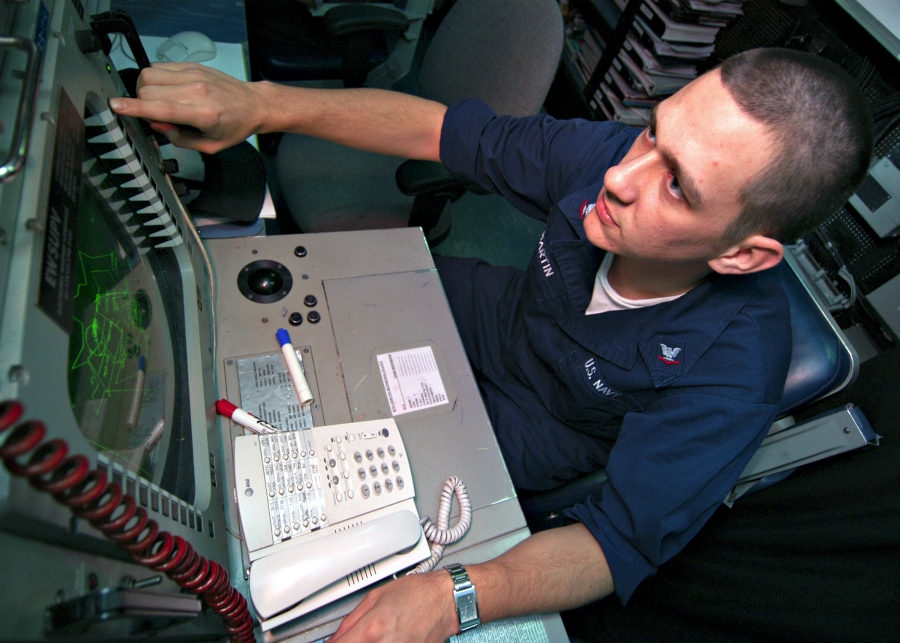Navy lacks electronic warfare capabilities for future fights at sea
02/02/2016 / By usafeaturesmedia

Image credit: Wikipedia Commons
(Cyberwar.news) Naval battles of the future will most likely first involve an electronic exchange, say experts, because interconnected cyber systems will control kinetic weapons systems like aircraft, missiles and rail guns.
As noted by Breaking Defense, warships will also need to coordinate and “talk” to each other in order to concentrate fire on enemy positions. Even before then they will have to communicate with forward-deployed assets including other ships, manned aircraft, drones and satellites that will be used to transmit targeting data back.
In order to make the most of the existing fleet of U.S. ships – which are declining, by the way – Navy leaders have been promoting a concept known as “distributed lethality,” or, generally, the notion that if it floats, it must fight as well. The plan involves pushing out small groups of warships – destroyers, frigates, cruisers and Littoral Combat Ships – in so-called Surface Action Groups that can disperse to avoid detection but still be able to concentrate long-range weapons on target.
Yet increasing that link – that vital cyber battlespace – is in danger of being lost, and that would put American warships at a distinct disadvantage at worst or give them no advantage at all in a naval contest at best.
As Breaking Defense noted further:
The problem is there’s no guarantee the “distributed” forces can communicate when they need to share targeting data or coordinate attacks. No less a figure than the Pentagon’s then-chief of research and engineering, Alan Shaffer, said in 2014 that “we have lost the electromagnetic spectrum.” It’s the spectrum where radio communications and radar detection both operate — as do the myriad electronic warfare systems that detect, deceive, and disrupt them.
“It’s a huge priority,” Rep. Randy Forbes, R-Va., told the web site.
“It’s not just the Pentagon that’s concerned about losing our advantage [in electronic warfare],” Forbes, chairman of the House Armed Services Committee’s subcommittee on seapower continued. “If you talk to some of the top CEOs at some of our defense contractors, they would take it a step further and say we’ve lost our advantage and now we’re playing catch-up.”
Increasingly, Navy leaders are concerned that future adversaries will be able to blind U.S. ships to incoming threats before destroying them, due to the loss of advantage in electronic warfare capability.
“Ships emitting very high-power, unique RF (radio frequency) waveforms that also have significant visual, infrared, and radar signatures — both the ships themselves and their wakes — will be increasingly susceptible to being located, tracked, and attacked from extended range,” former Navy undersecretary Bob Martinage told Breaking Defense. “Over the long run, at a minimum, this suggests a need to move toward less detectable means of sensing and communication.”
“Distributed lethality depends on electromagnetic maneuver warfare,” added Jonathan Solomon, senior systems and technology analyst at Systems Planning & Analysis Inc. “The initial phases of a distributed lethality operation will heavily leverage cyber/electronic warfare.”
Fortunately, the Navy has already begun training in so-called “contested” electromagnetic warfare environments – training that will be crucial in real-deal scenario.
But in order to build a “network” that is survivable, it will need to be redundant and resilient, other experts noted.
UPI reported Jan. 16 that the Navy recently awarded defense contractor General Dynamics a contract to upgrade the service’s EW systems.
“The Surface Electronic Warfare Improvement Program, or SEWIP, supports the integration of the AN/SLQ-32 Electronic Warfare system introduced in the late 1970’s,” UPI reported. “The system provides combat ships with detection, signal analysis, threat warning, and protection from anti-ship missiles.”
See also:
Cyberwar.news is part of the USA Features Media network of sites. For advertising opportunities, click here.
REUSE POLICY: You are free to reuse-republish articles that appear on this site in a digital format, because we believe the more people they reach, the larger the impact. All we ask is that you please include a direct link back to our site. Thank you in advance.
Tagged Under: electronic warfare, U.S. Navy




















